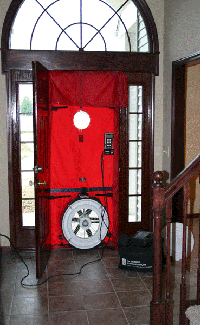Blower Door
Why is Building Leakage Important?
Leaky houses have problems ranging from drafts, blistering paint, ice dams and frozen pipes to a house that will not adequately heat or cool. Excessive air leakage is probably the cause if your home is drafty and excessively dry during cold weather, leading to static-electric shocks. Although air leakage does dilute pollutants and provides fresh air, it is not very reliable at these tasks. Air leakage tends to over-ventilate a home during cold windy weather and under-ventilate it during mild calm weather. We know that the most important leaks in a house are the hard to find leaks in the attic, crawlspace, attached garage and other framing connections. These hidden leaks are responsible for most of the air leakage in typical houses, and are often the cause of performance and durability problems.
Tight houses, without providing proper ventilation, can increase the potential for health and safety problems to occur. Higher moisture levels, found in inadequately ventilated houses, create an ideal environment for molds, dust mites and other causes of respiratory problems and allergies. Tighter houses are also more likely to experience problems from back-drafting and spillage of combustion products from naturally drafting furnaces, water heaters and fireplaces. This is because in tight houses, it is easier for exhaust devices (e.g. dryers, kitchen and bath fans) to create large pressure differences between inside and outside of the house, which can interfere with proper venting of the combustion appliances.
Measuring Building Airtightness
The way our Home Performance Analysts measure building airtightness is with a diagnostic tool called a blower door. The blower door consists of a powerful, calibrated fan that is temporarily sealed into an exterior doorway.
The fan blows air out of or into the house to create a slight pressure difference between inside and outside. This pressure difference forces air through all holes and penetrations in the building envelope. Blower door tests are typically performed at a pressure difference of 50 Pa (0.2 inches of water column). This give us your CFM50 number (cubic feet per minute at 50 pascals).
By simultaneously measuring the air flow through the fan and its effect on the air pressure in the building, the blower door system measures the airtightness of the entire building envelope. The tighter the building (e.g. fewer holes), the less air you need from the blower door fan to create a change in building pressure.
Airtightness measurements are presented in a number of different formats including:
- square inches of leakage area (as if you combined all the holes into one hole).
- This is the easiest to visualize.
- air flow needed to generate 50 Pa of pressure difference (CFM50).
- This is the actual measurement of your house's leakiness and what we compare to after the airsealing has been done.
- air changes per hour at 50 Pa of pressure difference (ACH50).
- This is used to compare to the current standards (3 to 5 ACH50).
Blower Doors only measure the total leakage, but it can also be used to estimate the amount of leakage between the conditioned space of the building and attached structural components such as garages, attics and crawlspaces. However, the blower door by itself does not show us where the leakage is located. By using the Blower Door in conjunction a manometer, pressure pan, thermal camera, and non-toxic chemical smoke, we can narrow down areas of concern (most leaky areas) and then locate the leakage in those areas. This is because the blower door forces air through all holes and penetrations, these problem spots are easier to find once we narrow down where to look.
Finally, while the blower door does not measure infiltration rates directly, test results can be used for the purposes of evaluating indoor air quality, the need for mechanical ventilation, and to help with proper sizing of heating and cooling equipment.
Interesting Links
Pennsylvania Housing Research/Resource Center -Blower Door Testing -or-(Cached copy)
GreenBuildingAdvisor -Blower Door Basics

